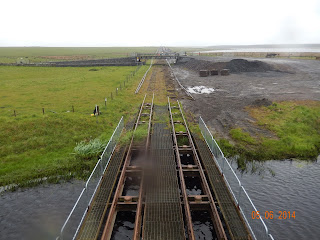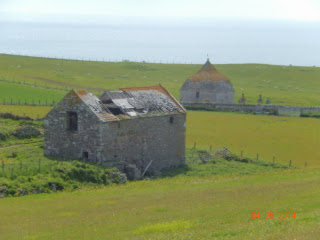 |
| The walking party for the last day. Alan, Tom and Rosemary |
Susan drove Alan, Rosemary and myself back to the Harbour
Brock turn-off in time for a 10:00 start. And it was back on the A99.
I had studied the map assiduously beforehand, and even
checked Google Earth in the hope that at least part of the way could be on
footpaths rather than the main road. But such hopes were dashed. It would be great
if one could cut off the road to the east at Skirza and then travel due north
to Duncansby Head, and on by the coastal path to John O’Groats, but there is no
footpath immediately north of Skirza. Given previous experiences of trying to
cross country with no clearly marked footpaths, this would have been a risk too
far – particularly on the last day of the whole walk.
 |
| We didn't actually see any pigs. |
So it was back on to the A99, with fervent wishes that the
Scottish government would do something to make the northern end of the
end-to-end walk more user-friendly. It is fascinating to conjecture (a) what
increase in walker numbers would be achieved if the walk was more attractive,
and the consequent economic benefit locally; and (b) whether there are any
walker injuries on the A9 and A99 as things stand now.
At least on this stage we found that drivers on the A99 were
considerate and friendly – they’d wave even if they felt obliged to come to a
complete stop to avoid us when there was traffic coming our way. It’s
presumably because they’re either locals used to walkers up here, or visitors
on their best behaviour.
Rosemary led the way (as she says, her natural walking pace
is higher than mine), and for most of the time Alan and I walked together 50
yards or so behind her – talking about everything from our respective
schooldays to current science issues and books we had read or felt we ought to
read. A pleasant way of passing the time on what was essentially rather a dull
walk.
 |
| Freswick Castle |
All of the country up here is pretty open, with the
exception of a few areas of forestry, mostly fairly distant from the road. The
differences are still pronounced. At some stages it’s relatively large fields,
at others much smaller crofting enclosures. There is also a fairly extensive
area of open moorland just before John O’Groats itself, where it becomes crofting
fields again. This moorland is heather on peat, with signs of significant
historic peak cutting and even some taking place today.
The only building of note on the way is Freswick Castle, now
privately owned and advertising itself as a house party or wedding venue. It’s now owned by Murray Watts, a playwright
and author, but its history includes (not surprising given where it is) a
period of Sinclair ownership – the family of the Earls of Caithness. There is also a mausoleum, now largely
ruined, and a dovecot.
Given the fact that it was all road walking and not very far
anyway, we were at the signpost in John O’Groats signifying the end of the walk
shortly by around 12:30.
So it was a short impatient wait until we had the signpost
to ourselves, and then time for photographs – just as the rain began. First
just me, as the one who had walked (rather slowly!) all the way from Land’s
End, and then Rosemary, Alan and myself. The original intention had been to
have a glass of champagne there and then, but we deferred the alcoholic part of
the celebration until later in the day. So for now it was just coffee and
snacks in the rather good café run by Natural Retreats.
 |
| Stacks of Duncansby |
Later that day we went up to Duncansby Head to make sure
that I hadn’t only finished the “official” end to end journey, but had also
visited the point on the mainland most distant from Land’s End. This was a much
more interesting experience than the last stage of my end-to-end route –
fantastic cliffs, huge numbers of nesting fulmars, kittiwakes, auks, shags –
the spectacular sight of the Stacks of Duncansby. Well worth the extra few
kilometres of walking to see it all. Sunny again, now, but a real gale in our
faces as we got back to John O’Groats.
How did I feel? Pleased, and satisfied, that I had completed
the walk. But I have to say that the last few days had been disappointing, with
few footpaths and too much road walking – mostly on the A9m and A99. One would
have liked to finish on a high – great scenery, and wonderful weather. So it
was in some ways a bit of an anti-climax.
 |
| Finally there! |
And now I can start thinking about the next challenge. We
shall see!
Bright, with sunny
intervals, but getting cloudier towards the end of the morning with a downpour
just as we finished the whole walk. 12 to 14C. 11.27 km; 127m of ascents and 143m
of descents. A99 all the way.






























